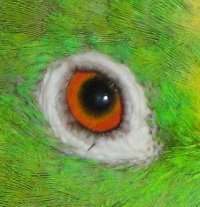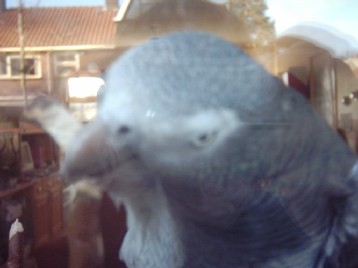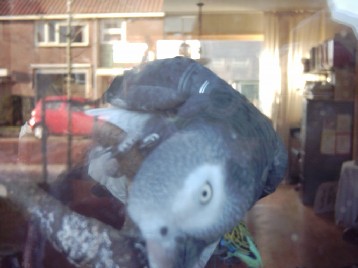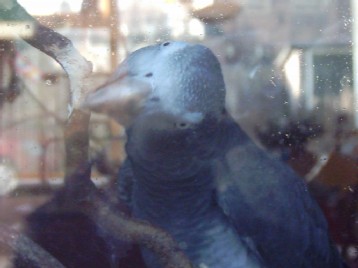NEW ADDRESS FOR MEMBERS GREYFORUMS.ORG
-
Posts
78 -
Joined
-
Last visited
Content Type
Profiles
Forums
Events
Gallery
Everything posted by Animalspirit
-
As it is said in the other shoulder topics: it depends on the bird. I have 7 birds and some of them I do allow on my shoulder, others I don't. For instance, I don't allow Fernando, my TAG there. He has a habit of sneekily climbing up there, and suddenly snap! in my earlob, or neck. So he can sit on my lap while I'm watching tv. I don't allow my Yellow Crowned Amazon there, for the same reason. Sometimes I hear him chuckling behind my back when I'm sitting at the computer, and I know what he's up to... But my Orange-Winged Amazon is a sweet, but timid bird. He may sit there while I'm scratching his head. My Blue Fronted Amazon likes to sit on my shoulder 24/7. She preens my face and neck, and yesterday discovered a sensitive spot there, I got the shivers all over when she's preening there. So she continues of course! But... she is female, and in the springtime it's mating time. I have to be careful then, because her hormons start to work. She is not interested in male amazons, only in humans. And she lays eggs if I don't put her away in time. I'm telling you this, because it can also happen with African Grey females. If she's comfortable on your shoulder, and never bites, you can recognize sexual behavior this way: lowered, trembling wings, rubbing, lowered head, cooing sounds. This was the way in which Tabu, my first grey, tried to get the attention of other greys. Time to put her away for a while!
-
We have them here in Holland, too, but I don't really trust them. So I bought a high quality stainless steel frying pan, because my parrots love to join me in the kitchen. So no special layers on the pan, just me watching carefully the meal I'm cooking, and stirring of course. I don't want to risk anything!
-
According to my avian vet, my TAG Fernando must be about 40 years old. Parrots of that age here in Holland are most certainly wild caught. They can be trained, though: Fernando learned to step up before he came to me. I recently started really training him: just for fun I tried how much time he needed to learn a "turn"for instance. It took him only 5 minutes to understand the trick! Parrots are so intelligent, they have the level of a 2- to 5-year old child. And they keep learning all their life! So, regardless the age, you can certainly train that bird!
-
If they love pellets better than veggies, they will eat them first. Birds always choose what they like best and what's large. I give my birds veggies, fruits, beans and nuts in the morning, and later on they get their pellets. In the evening they get some seeds before they go to bed. If you want them to eat something they are not used to, you can start by giving them just the carrot, adding the pellets later. Don't show any concearn, they will notice. My TAG didn't know carrots when he came here, now he loves them. Sometimes he doesn't eat any of his veggies but the next day he does. I don't worry about that. BTW, I noticed that my birds have different taste. All my birds eat banana, only my rosella doesn't. That's no problem, he'll eat everything else, especially pellets. And pellets are complete food, after all! Did you try wild rosehips? I regularly pick them when I walk the dogs. My parrots love them!
-
Of course she does! She sees you eating it, and you know, parrots learn from obeserving each other. In the wild their parents teach them what's good for them and what not. If she's the only parrot between humans, she learns from you what she should eat. What I mostly do, is taking a bite of the food myself, telling them how good it tastes, and put it in their bowl without looking at it anymore. Don't worry, if she's playing with the food. This is what parrots do. they try the food, they play with it first. Finally she will try and eat it, because you did! I think it's also better not to eat a pizza in presence of your bird, at least, for a while. Give her foraging toys with healthy food, and teach her finally to leave your meals alone.
-
This is a serious problem. But... there are ways to change his behavior. First you have to ignore the screaming ( but not the bird of course) and you have to replace the sreaming sound with something nicer. I don't want my parrots to scream, so I always play classical music for them, or Bocelli. This type of music has a relaxing effect on animals. If they do start screaming after all, I do something that attracts their attention. For instance, I walk to the other side of the room, grab a chair and push it aside. Your parrot will follow your movements and be quiet for a moment. At the moment he shuts his mouth, I reward him bij praising him abundantly, and giving him a tiny piece of his favorite snack. So he will learn that being silent is rewarded. And he wants a reward, because at that moment he gets your attention. Good luck, and don't give up!
-
No, not a Gag, but a Cag! "C A G" stands for "Congo African Grey", Congo is the main country where they originally came from.
-
My parrots have their own bedroom where their sleeping-cages are. In the evening, when I watch tv, they call me when it's their bedtime. When there is a programme that they like, they watch with me until they're no longer interested. Last Christmas "The sound of Music" was on tv, and we watched until the end of the programme, with the parrots singing along! Watching tv with the parrots in a covered cage in the living room, wouldn't allow them enough rest.
-
The Congo African Grey Psittacus Erithacus lives mainly in Congo and Ghana, and it is said, that the birds are smaller and darker if they come from the south. Their tail is bright red, and their beak black. The Timneh African Grey Psittacus Erithacus Timneh, a subspecies of the CAG,lives mainly in Tanzania, and is smaller than the CAG. Thr feathers are darker, while the breast and underside are lighter. The tail is wine or dark ruby red, sometimes a little brownish. The upper mandible of the beak is liver/pink colored. There isn't that much difference in behavior between the two species. Both are intelligent and playful, and both have the same contact-calls. It is said, that the TAG in the wild is even more difficult to approach than the CAG, because of his shyness. However, I have seen problem behavior such as plucking and biting in both species. I have seen more manipulative behavior with CAG's, but maybe that's because they are more common as a pet bird. I don't know what the situation in the USA is like, but here in Holland the CAG is more often bred because of its popularity. There are breeders that breed with second-hand birds, which are often given away because of plucking behavior. If one breeds with a plucker, the chance increases that the chicks will have a predisposition for plucking behavior. So, at least here in Holland, there are more plucking CAG's than TAG's.
-
If you can't find any classes in your area, I would recommend the online course "LLP", Living and Learning with Parrots to you. http://www.birdendowment.org/LLP/LLP.shtml I did this online course, because there weren't much classes in our country at that moment. It has been proved very valuable for me and for my parrots, too!
-
This is a real fun video! there are still people that don't believe that parrots know what they're saying, but this video definitely proves it! Great, & thanx for sharing!
-
All my birds are pets too, but they're all adopted. I hope the starter of this topic will succeed in taking home the bird. Indeed, there are too many birds waiting for a new home, and I'm happy to read that someone is willing to adopt one. Of course, adopting a bird requires a lot of studying, especially when you have already a bird in your home. The cause of so many birds in rescue homes is in many cases people buying a cuddly, downy parrot chick with black eyes, without exactly knowing what kind of animal they take in their homes. They act on impulse, and often don't think of the consequences. Someone who adopts a parrot,is mostly conscious of his choice.
-
I agree on everything said above. Parrots are birds that normally live in groups, so I never advice people to just keep one bird. Greys will mostly keep distance, unless they are partners. ( South-american birds like amazons have often more friends within the group, that they preen). Never force them together in one cage, just to save space. Later, if they prove to accept each other you can have them on a play-tree in the living room and have separate cages for them just to sleep in.
-
Hi Jennifer! Well, I'm very happy to read about your research before buying a grey. I wish more people did that! I give my birds also Harrisson's organic food. But in the morning they get fresh cooked beans, raw veggies, fruit and walnut. Walnut is important because of the calcium level. Here in Holland too many adopted birds suffer from hypocalcemia, because they had only seeds and a little fruit for years. So I give them a "calcium boost" by giving walnut and broccoli. BTW the Harrisson's site has also a lot of information, and if you have any question about the pellets, they will always answer. I once got even a mail from Dr. Harrisson himself! If you like to prepare your own special parrot food: there are also recipe books with delicious meals for parrots.
-
Of course they do! My living room looks quite messy... The alternative is putting them in cages, but I hate to have them all day in separate cages just for the sake of my furniture. So I give them cardbord boxes, willow and elder branches and old telephone books and pine cones to chew on, put the computer on a classical station, turn on one light in the corner and go to work. Of course all wires are hidden in pvc tubes or heavily taped, otherwise I couldn't have them free all day safely. This way the damage is limited, they are happy and I'm happy because they are. I have no partner, so it doesn't matter too much what my living room looks like.
-
"Hey you, ARE YOU LISTENING?" She, of course, couldn't do antything but go home, grab the camera and registrate this little caretaker. My home is well guarded!
-
-
When I am not at home, the parrots are roaming free in my living room. ( except Asterix, the rosella, who is a little too agressive and is in a large cage during my absence). My neighbour comes to walk the dogs every day, and when she comes, she is welcomed by Fernando, sitting at the window.
-

Changing your birds name? Please advise!
Animalspirit replied to Anmlhggr's topic in The GREY Lounge
Well, I have adopted many birds, and I changed names too! My first grey was called Tabu, which was a congolese name so I kept it that way. My old amazon's name was Lorre, but in the past many of the birds( especially amazons) in Holland had that name, so I changed it to "Borre", a name from a children's book. Then I got the rosella, whose name was "Coco", which is also a very common name here in Holland. I re-named him "Asterix", after a comics character very similar to his character. There has been another Coco, a grey, who was going to stay here. I had already re-named her "Catootje" but sadly enough she suffered from hypocalcemia and died. The third Coco is my blue-fronted amazon, now called "Cootje". My Yellow Crowned Amazon was first called "Ruby", because the owner thought that it was a female bird. But it proved to be a male, and I re-named him "Rumi"after the famous persian poet who wrote a lovely story about a parrot. Of these birds, Asterix and Cootje don't speak. Borre could speak very well, but parrot speech is like ventriloquizing: they have no lips, so they can't pronounce many consonants. "Lorre"and "Borre"sound just the same. And there's not a real difference between "Ruby"and "Rumi". Fernando came from the asylum, after he was left behind in a house. They called him "Fernando"at the asylum, but I think his name was "Jipje" or "Jobje", because he keeps saying it. He listens to his name "Fernando", though. -

Cute traditions you have with your Grey
Animalspirit replied to EFGriffith's topic in The GREY Lounge
Every evening when I come home from work Fernando, my TAG, is sitting in the front window and starts to whistle when he sees me. One of the other parrots always says "Heyyy, hellooo!" Then I give them all some seeds to nibble on before they go to bed. First the amazons, and then Fernando, my rosella and the lovebirds. Climbing the stairs I sing songs, I whistle a tune and Fernando whistles along, his head bobbing and he's making clicking sounds too. In the parrot bedroom I talk in a low voice and say goodnight. Fernando sometimes loves wild games. He tries to bite my shoes or even my bare feet. He comes very sneaky on tiptoe to do so... When I have my slippers on, I take them off and say: "Watch it, Fernando, I'm going parrot-slapping! I hit the floor with the slippers, and he jumps up and down, saying "Come, come!" Sometimes we watch tv together. Fernando loves watching movies like "Lord Of The Rings", and he's very good at mimicking the "Ringwrights". When we watch tv, he often comes sitting on my knee. He also likes jazzy music, he mostly starts dancing when he hears it. My parrots clearly have a different taste in music! -
I agree on that! Watching fireworks safely behind a window is ok, but outside is really too dangerous.
-
Here in Holland there's only fireworks around New Year's Eve, but sometimes children are playing with fireworks weeks before that night. It can be very dangerous having your pets free in the garden at that time. Once I came on my bicycle along a rather dark road, and I saw a dog being killed by a car passing by. It was a female Staffordshire Terrier, and she had run away from the garden because she was frightened by the fireworks. At New Year's Eve I make sure all animals are in, especially my cat. I walk the dogs before the big fireworks start. They're not afraid at all, so they do what they must do, and then they lay down in the house very relaxed and quitly. The parrots love watching the fireworks! Especially my first grey Tabu loved it! When the fireworks start, I take all parrots upstairs to my bedroom, which is at the street side, and together we watch. Weeks after the fireworks they still make firework sounds!
-
The average parrot needs 10-12 hours of sleep/rest. When you look at tropical areas, you will notice that darkness falls far more suddenly than in northern areas. That can be 12 hours of darkness. So I put a darkening screen for the window of my parrot-bedroom. They go to bed between 10.00 and 11.00 pm and come out of the room somewhere between 10.00 and 11.00 am. So they get their 12 hours of darkness and rest. Then I go to the bathroom to shower with them, and after that I take them to their play trees where some of them first get their training and all of them get their breakfast. Like all animals, they take sometimes a little nap between 2.00 and 3.00 pm, between preening etc. Maybe your grey just wants to stay with the group, which is you and your husband. My group mostly stays together, so they don't mutter.
-
My birds go to bed somewhere between 10.00 and 11.00 pm, depending on the time I'm home from work. When I come home I give them some seeds to nibble on, before they go to sleep, and they often come to me to keep me company at the computer or in front of the TV. They also ask me to bring them to bed: Stud, one of the lovebirds, starts asking my attention by jumping up and down my shoulder and being very cuddly, and Fernando, the TAG, says "Come!" Then I first take the amazons to bring them upstairs, and then I come back to take the lovebirds, the rosella and the TAG to their sleeping cages. Sometimes I hear Fernando in his sleeping cage reacting on something that happens downstairs, mostly by whistling the "contact-whistle". Thsi happens when I take the dogs outside for their last walk. I answer him mostly by telling him that he should sleep by now. After that he goes to sleep. A new bird goes along with the others to get used to the rhythm here. No problems here, because I am just one group member, and the rest of the group is together in the bedroom.
-

Now the real introduction...
Animalspirit replied to Animalspirit's topic in Welcome & Introduction Room
That is the eye of my old amazon Borre, who died last year, but who will live on as my logo and avatar. To get to know him, and to understand him, was a wonderful experience. They say that one can see the soul through the eyes, the spirit of the animal so to say. Therefor I chose the name "Animalspirit" for as a behavior therapist you have to find out what moves the animal/parrot.




